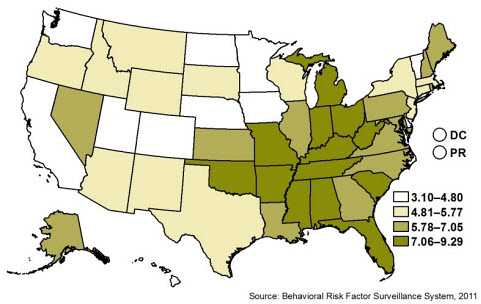Fact Sheets
The map below depicts quartiles of age-adjusted COPD prevalence (%). Select a state or territory from the drop-down menu or from the map to open the fact sheet for that particular state or territory.

Fact sheets on COPD are available for all 50 states, the District of Columbia, and Puerto Rico. Each fact sheet provides a table with the reported prevalence of COPD among adults in the state or territory by age, race/ethnicity, sex, employment status, education level, household income, marital status, smoking status, and asthma history. Each fact sheet also includes a figure depicting health and healthcare characteristics by COPD status. Data obtained through Behavioral Risk Factor Surveillance System.
In 2011, some states also collected additional information from respondents with COPD about using a diagnostic procedure, daily medication use, physician visits, hospital or emergency room visits, and how shortness of breath affects quality of life. In many states, adding these questions was supported by an interagency collaboration between the National Heart, Lung, and Blood Institute and CDC.
- Page last reviewed: March 12, 2015
- Page last updated: March 12, 2015
- Content source:


 ShareCompartir
ShareCompartir